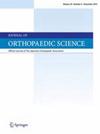Minimal clinically important difference in the Japanese Orthopedic Association Score and shoulder 36 after arthroscopic rotator cuff repair in a Japanese population: A retrospective cohort study
IF 1.4
4区 医学
Q3 ORTHOPEDICS
引用次数: 0
Abstract
Background
In Japan, the Japanese Orthopedic Association (JOA) score is widely used as a clinician-reported outcome after shoulder surgery. However, Shoulder36 is positioned as a general patient-reported outcome measure. This study aimed to determine the correlations between the JOA score and scores in the domains of the Shoulder36 and their minimal clinically important differences (MCIDs) and cutoff values for the patient-acceptable symptom state (PASS) after unilateral arthroscopic rotator cuff repair (ARCR).
Methods
We evaluated 145 patients using the JOA score and Shoulder36 before and 1 year after surgery. The MCID and PASS cutoff values were determined by patients’ responses to the following anchor item: A, none (“no good at all”); B, poor (“some effect but unsatisfactory”); C, good (“satisfactory effect with occasional episodes of pain or stiffness”); D, excellent (“ideal response, virtually pain-free”). The correlations between the JOA score and the domains of the Shoulder36 were statistically calculated. The border between B and C was defined as the threshold for PASS.
Results
There were significant correlations between the JOA score and the Shoulder36 domains. The responses to the anchor item were as follows: A (n = 0), B (n = 21), C (n = 76), and D (n = 48). The MCID for the JOA score was 19.5 points and the MCIDs for Shoulder36 were 0.5 points for pain, 0.667 for range of motion, 0.67 for muscle strength, 0.3 for general health, 0.571 for activities of daily living, and 1.0 for sports ability. The PASS cutoff value was 89.0 points for the JOA score and 3.8 points for pain, 3.667 for range of motion, 3.0 for muscle strength, 3.7 for general health, 3.7 for activities of daily living, and 3.0 for sports ability in the Shoulder36.
Conclusions
The MCID and cutoff PASS values for the JOA score and Shoulder36 identified in this study will help to determine the effectiveness of multidisciplinary management after ARCR.
日本骨科协会评分与肩关节镜下肩袖修复术后临床意义最小差异 36:回顾性队列研究。
背景:在日本,日本骨科协会(JOA)评分被广泛用作肩部手术后临床医生报告的结果。然而,Shoulder36 被定位为患者报告的一般结果测量指标。本研究旨在确定单侧关节镜肩袖修复术(ARCR)后 JOA 评分与 Shoulder36 各领域评分之间的相关性及其最小临床重要差异(MCID)和患者可接受症状状态(PASS)的临界值:我们使用 JOA 评分和 Shoulder36 对 145 名患者进行了术前和术后一年的评估。根据患者对以下锚点项目的回答确定 MCID 和 PASS 临界值:A,无("完全没有效果");B,差("有一定效果,但不令人满意");C,好("效果令人满意,但偶尔出现疼痛或僵硬");D,优("效果理想,几乎无痛")。统计计算了 JOA 评分与 Shoulder36 领域之间的相关性。B 和 C 之间的边界被定义为 PASS 临界值:结果:JOA 分数与 Shoulder36 领域之间存在明显的相关性。对锚点项目的回答如下:A(n = 0)、B(n = 21)、C(n = 76)和 D(n = 48)。JOA 评分的 MCID 为 19.5 分,而 Shoulder36 的 MCID 分别为:疼痛 0.5 分、活动范围 0.667 分、肌肉力量 0.67 分、一般健康 0.3 分、日常生活活动 0.571 分和运动能力 1.0 分。在 Shoulder36.Conclusions 中,JOA 评分的 PASS 临界值为 89.0 分,疼痛为 3.8 分,活动范围为 3.667 分,肌肉力量为 3.0 分,一般健康为 3.7 分,日常生活活动为 3.7 分,运动能力为 3.0 分:本研究确定的 JOA 评分和肩关节 36 的 MCID 和 PASS 临界值将有助于确定 ARCR 后多学科管理的有效性。
本文章由计算机程序翻译,如有差异,请以英文原文为准。
求助全文
约1分钟内获得全文
求助全文
来源期刊

Journal of Orthopaedic Science
医学-整形外科
CiteScore
3.00
自引率
0.00%
发文量
290
审稿时长
90 days
期刊介绍:
The Journal of Orthopaedic Science is the official peer-reviewed journal of the Japanese Orthopaedic Association. The journal publishes the latest researches and topical debates in all fields of clinical and experimental orthopaedics, including musculoskeletal medicine, sports medicine, locomotive syndrome, trauma, paediatrics, oncology and biomaterials, as well as basic researches.
 求助内容:
求助内容: 应助结果提醒方式:
应助结果提醒方式:


